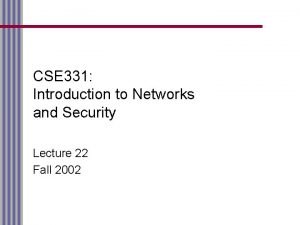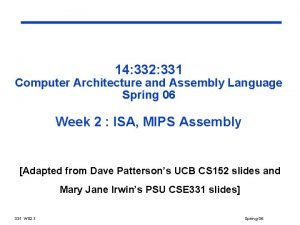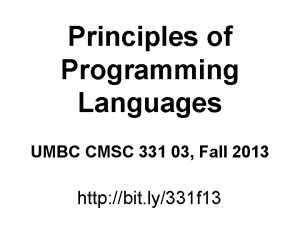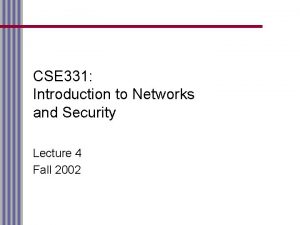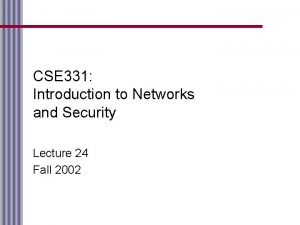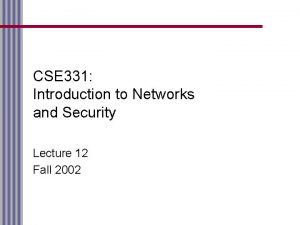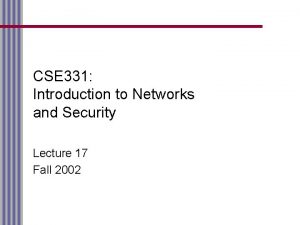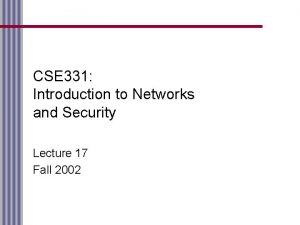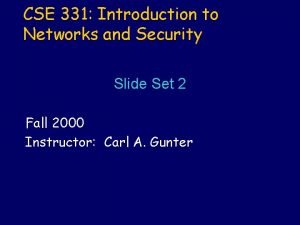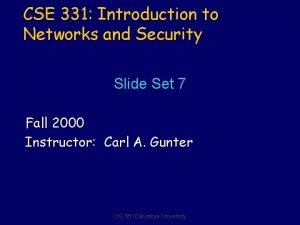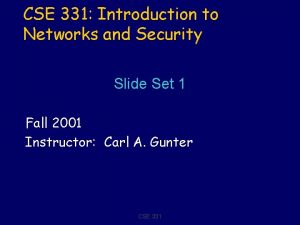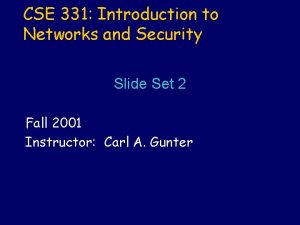CSE 331 Introduction to Networks and Security Lecture


















- Slides: 18

CSE 331: Introduction to Networks and Security Lecture 22 Fall 2002

Announcements • Project 3 is available on the web – Get started early! – It’s due 18 Nov. • Class is cancelled next Wednesday (Nov. 6 th) • TA will cover projects 3&4 in class Friday, Nov. 8 • Professor Gunter will be giving lectures on Nov. 11 th and 13 th CSE 331 Fall 2002 2

Project 3 • Distributed Bank Simulation – Java Network Programming – Cryptix Libraries for cryptographic protocols • Requirements – Authentication Protocol – Transaction Protocol – Audit Logs • Lab support on its way… CSE 331 Fall 2002 ATM Client Bank Server 3

Recap • Cryptographic Hashes • Digital Signatures • Today: – Protocols – Authentication CSE 331 Fall 2002 4

Protocols: Where We’re Going • • • Overview Entity Authentication Key Establishment SSL Kerberos CSE 331 Fall 2002 5

General Definition of “Protocol” • A protocol is a multi-party algorithm – A sequence of steps that precisely specify the actions required of the parties in order to achieve a specified objective. • Important that there are multiple participants • Typically a situation of heterogeneous trust – Alice may not trust Bart – Bart may not trust the network CSE 331 Fall 2002 6

Characteristics of Protocols • Every participant must know the protocol and the steps in advance. • Every participant must agree to follow the protocol • Big problem: How to deal with bad participants? – 3 basic kinds of protocols CSE 331 Fall 2002 7

Arbitrated Protocols Tom Alice Bart • Tom is an arbiter – Disinterested in the outcome (doesn’t play favorites) – Trusted by the participants – Trusted 3 rd party CSE 331 Fall 2002 8

Arbitrated Protocols (Continued) • Real-world examples: – Lawyers, Bankers, Notary Public • Issues: – – – Finding a trusted 3 rd party Additional resources needed for the arbitrator Delay (introduced by arbitration) Arbitrator might become a bottleneck Single point of vulnerability: attack the arbitrator! CSE 331 Fall 2002 9

Adjudicated Protocols Alice Evidence Bart acted fairly. Tom Evidence • Alice and Bard record an audit log • Only in exceptional circumstances to they contact a trusted 3 rd party. (3 rd party is not always needed. ) • Tom as the adjudicator can inspect the evidence and determine whether the protocol was carried out fairly CSE 331 Fall 2002 10

Self-Enforcing Protocols You’re cheating, Alice! Alice Bart • No trusted 3 rd party involved. • Participants can determine whether other parties cheat. • Protocol is constructed so that there are no possible disputes of the outcome. CSE 331 Fall 2002 11

Examples We’ve Seen • Arbitrated Protocol – Shared key digital signature algorithm – Trusted 3 rd party provided authenticity • Adjudicated Protocol – Public key digital signature algorithm – Trusted 3 rd party provided non-repudiation CSE 331 Fall 2002 12

Example: Shared-Key Authentication Alice Bart KAB • Assume Alice & Bart already share a key KAB. – The key might have been decided upon in person or obtained from a trusted 3 rd party. • Alice & Bart now want to communicate over a network, but first wish to authenticate to each other CSE 331 Fall 2002 13

Solution 1: Weak Authentication Alice Bart KAB KAB • Alice sends Bart KAB. – KAB acts as a password. • The secret (key) is revealed to passive observers. • Only works one-way. – Alice doesn’t know she’s talking to Bart. CSE 331 Fall 2002 14

Solution 2: Strong Authentication Alice I’m Alice Bart Challenge: Encrypt RB Response: KAB{RB} Challenge: Encrypt RA KAB Response: KAB{RA} KAB • Protocol doesn’t reveal the secret. • Challenge/Response – Bart requests proof that Alice knows the secret – Alice requires proof from Bart – RA and RB are randomly generated numbers CSE 331 Fall 2002 15

(Flawed) Optimized Version Alice, RA Bart RB, KAB{RA} KAB{RB} KAB • Why not send more information in each message? • This seems like a simple optimization. • But, it’s broken… how? CSE 331 Fall 2002 16

Attack: Marvin can Masquerade as Alice, RA RB, KAB{RA} Bart Alice, RB R’B, KAB{RB} KAB • Marvin pretends to take the role of Alice in two runs of the protocol. – Tricks Bart into doing Alice’s part of the challenge! – Interleaves two instances of the same protocol. CSE 331 Fall 2002 17

Lessons • Protocol design is tricky and subtle – “Optimizations” aren’t necessarily good • Need to worry about: – Multiple instances of the same protocol running in parallel – Intruders that play by the rules, mostly • General principle: – Don’t do anything more than necessary until confidence is built. – Initiator should prove identity before responder takes action (like encryption) CSE 331 Fall 2002 18
 Uw cse 331
Uw cse 331 Cse 331
Cse 331 Private securty
Private securty Difference between virtual circuit and datagram subnet
Difference between virtual circuit and datagram subnet 01:640:244 lecture notes - lecture 15: plat, idah, farad
01:640:244 lecture notes - lecture 15: plat, idah, farad Backbone networks in computer networks
Backbone networks in computer networks Computer security 161 cryptocurrency lecture
Computer security 161 cryptocurrency lecture Ce 331
Ce 331 Ssis 331
Ssis 331 14:332:331
14:332:331 14:332:331
14:332:331 Fin 331 exam 1
Fin 331 exam 1 Cse 332 p3
Cse 332 p3 Ist 331
Ist 331 Umbc languages
Umbc languages Cmsc 331
Cmsc 331 Ce 331
Ce 331 Ist 331
Ist 331 Cmsc 331
Cmsc 331

